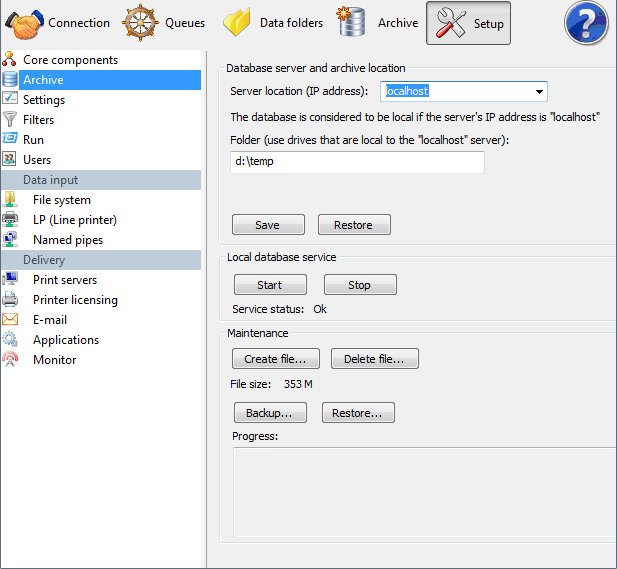Archive
Archive manages the database server and archive location, monitors the local database service status, and performs maintenance.
Logging is to a FireBird data base (also 32 or 64 bit). The DB need not be on the same machine or operating system.
FTSpooler has one FireBird database for all the job processing and delivery information. Location is stated in Database server and archive location. Recovery is built-in by logging of the data for each task before release to the external process. The database deletes no longer required transactions several times per day, and you should schedule Backup and Recovery as the database gets too large. Backup and Recovery removes deleted space from the database, returning it to the system as free space.
Note: Setup of the archive on another machine is not a part of these instructions. Please contact support@formtrap.com for details and a quotation if you would like your system set up this way.
- Select the Server location (IP address) from the dropdown menu. "localhost" means the database is located on the local machine.
- Enter the Folder name, and make sure to use drivers that are local to "localhost" server.
Start or Stop the Local database service and check status. Jobs in Archive View will only display if the Service status is Ok.
Note: It is not recommended to stop the Local database service as FTSpooler stops operating. The only case would be to obtain a “cold” backup of the database.
The current File size can be found in the Maintenance section.

The FireBird DB operates as “high watermark” meaning the file size never shrinks, instead deleted space is re-used. The DB auto-expands until the point where deletions roughly equate to additions, at which time it stabilizes. That is typically around the 10 GB mark and depends on the retention period "Number of days to keep records" in Queues, General tab. A zero value in Number of days ... means indefinite retention, hence a large and growing DB. Deletion of obsolete records happens several times per day and is automated by the Spooler.
You may place the DB on a different drive, this is recommended if your DB is large and infrequently backed up and restored.
Managing your DB
These tools are available to control your FireBird DB.
Save and Restore save an exact copy of the DB and can be used for restoring in the event of a DB outage. Backup... and Restore... are preferred.
Backup... and Restore... are used to bring the DB back to minimum size. FireBird does not recover deleted space (but does reuse deleted space, so while the DB may not shrink, it has room for additions). Backup/Restore recovers deleted space. Stop archiving prior to Backup/Restore and Start archive when completed.
Delete file... and Create file... allow deletion of the entire current DB and replacement with an empty DB. Stop prior and Start when complete. You should wait around 30 seconds after Delete file... before pressing the Create file... command.

